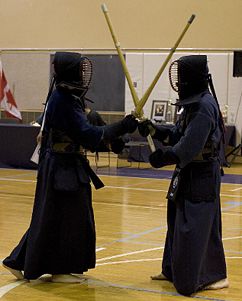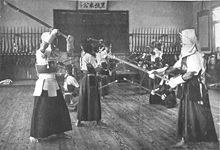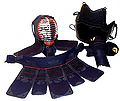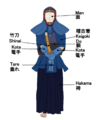Difference between revisions of "Kendo" - New World Encyclopedia
Keisuke Noda (talk | contribs) (from wikipedia) |
Keisuke Noda (talk | contribs) m |
||
| Line 139: | Line 139: | ||
[[Category:Combat sports]] | [[Category:Combat sports]] | ||
[[Category:Japanese martial arts]] | [[Category:Japanese martial arts]] | ||
| − | + | [[Category:Japanese culture]] | |
| − | + | [[Category:Zen Buddhism]] | |
| − | + | [[Category:Philosophy and religion]] | |
| − | + | [[Category:Art, music, literature, sports and leisure]] | |
| − | |||
| − | |||
| − | |||
| − | |||
| − | |||
| − | |||
| − | |||
| − | |||
| − | |||
| − | |||
| − | |||
| − | |||
| − | |||
| − | |||
| − | |||
| − | [[ | ||
| − | [[ | ||
| − | [[ | ||
| − | [[ | ||
{{credit|47580937}} | {{credit|47580937}} | ||
Revision as of 04:19, 10 April 2006
| Kendo | |
|---|---|

| |
| Japanese Name | |
| Japanese | 剣道 Kendō |
| Kana spelling | けんどう |
| Rōmaji (Hepburn) | Kendo |
| Kunrei-shiki | Kendo |
| Nihon-shiki | Kendo |
Kendo (剣道 Kendō) , is the martial art of Japanese fencing, developed from traditional techniques of Japanese swordsmanship known as kenjutsu. Since 1975 the goal of Kendo has been stated by the All Japan Kendo Federation as "to discipline the human character through the application of the principles of the katana (the Japanese standard two handed sword)". However, Kendo combines martial arts values with sport elements, with some practitioners stressing the former and others the latter.
Taught using "swords" made of split bamboo (shinai) and extensive protective armour (Bogu), practitioners are called kendoka or "kenshi". Kendoka merely means one who practices kendo. Kenshi means swordsman. Both terms are used, though many clubs have a preference for one term. Kendoka also use bokuto (wooden katana) to practice set forms known as kata. On formal occasions, real swords or metal swords with a blunt edge, called habiki, can be used. There are 8 basic Scoring Regions.
History
Kendo, "The Way of The Sword", embodies the essence of the Japanese fighting arts. Since the earliest samurai government in Japan, during the Kamakura period (1185-1233), sword fencing, together with horse riding and archery, were the main martial pursuits of the military clans. In this period Kendo developed under the strong influence of Zen Buddhism. The samurai could equate the disregard for his own life in the heat of battle, which was considered necessary for victory in individual combat, to the Buddhist concept of the illusory nature of the distinction between life and death.
Since that time many warriors have become enlightened through Kendo practice. Those swordsmen established schools of Kendo training which continued for centuries, and which form the basis of Kendo practice today. The names of the schools reflect the essence of the originator’s enlightenment. Thus the Itto-Ryu (Single sword school) indicates the founder’s illumination that all possible cuts with the sword emanate from and are contained in one original essential cut. The Muto (sword less school) expresses the comprehension of the originator Yamaoka Tesshu, that "There is no sword outside the mind". The 'Munen Muso Ryu’ (No Intent, No preconception) similarly expresses the understanding that the essence of Kendo transcends the reflective thought process.
The formal Kendo exercises set down sometime several centuries ago are studied today using wooden swords in set forms, or 'kata'. The present form of using "shinai" and "bogu" is started in the 18th century by Naganuma Sirozaemon Kunisato (長沼四郎左衛門国郷 1688-1767). Training using bamboo practice swords and substantial armour includes both formal exercises and free fencing. Thus today it is possible to embark on the quest for spiritual enlightenment followed by the samurai of old. Concepts such as 'Mushin', or 'empty mind' as professed by exponents of Zen are an essential attainment for high level Kendo. Fudoshin, or 'Unmoving Mind', a conceptual attribute of the deity Fudo Myo-O, one of the five 'Kings of Light' of Shingon Buddhism, implies that the fencer cannot be led astray by delusions of anger, doubt, fear, or surprise arising from his opponent’s actions.
In 1920, Dai Nippon Butoku Kai (大日本武徳会, developer of the Japan Martial Arts Foundation) changed the name of Gekiken (撃剣, "hitting sword") to Kendo.
Modern Kendo
In modern kendo, there are two types of attacks - strikes and thrusts. Strikes are allowed against only certain areas on the body, datotsu bui. The valid targets are men (top of the opponent's head), sayu-men or "yoko-men"(the left and right side of the opponent's head), right kote, or wrist at any time, the left kote when it is in a raised position (such as jodan), the left or right do (in tournament situations points are rarely awarded for striking the left side of the opponent's do). Thrusts are only allowed to the throat (tsuki). However, since a wrongly done thrust could injure the neck, thrust techniques are often left out at the starting level and practiced at later levels.
- Wikikendo2.JPG
Nihon Kendo Kata.
- Kendo EM 2005 - taiatari.jpg
Two kendoka face off.
In matches, a point is only awarded when the attack is done firmly and properly to any of the allowed targets with Ki-ken-tai-ichi, or spirit, sword, and body as one as well as "Zanshin" or continuation of awareness. This means for an attack to be successful the shinai must strike a proper target at the same time the attacker's front foot makes contact with the ground and at the same time of kiai or shout that displays good spirit. Though it is common, especially in matches within a dojo, kiai need not be the name of the target that is being struck.
In a tournament, there are three judges (shinpan), each holds a red and a white flag in opposing hands. Each competitor has either a white or red ribbon attached to his or her back. For a point to be awarded, a minimum of two judges must agree. To signal this, the judges raise the corresponding coloured flag of the player who scored the point. The first to score two points wins the match. If the time limit runs out before two points are awarded, several things may happen: If one player has one point and the other does not, then the player with one point wins. In cases of a tie, the match may be declared a draw or decided by a period of overtime, sudden death overtime (the first to score a point wins regardless of time left), or a hantei, or judges' decision.
The International Kendo Federation (IKF) has members in 45 countries. The international championships are held every three years since 1970, when the IKF was founded.
Kata
There are 10 Kata which are performed with either a wooden sword (bokken/bokuto) or occasionally with a blunt edged sword. Kata 1~7 are performed with both partners using a bokken of around 102 cm. Kata 8~10 are performed with one partner using a bokken and the other using a kodachi of around 55cm. During kata, the two participants take the roles of uchidachi (teacher, this side always is the 'losing' side in kata) and shidachi (student, this is the 'winning' side).
Ranking
Technical achievement in Kendo is measured by advancement in grade, rank or level. The "kyu" and "dan" system is used to assess the level of ones skill in kendo. The dan levels are from 1-dan (sho-dan) to 10-dan (ju-dan). 1-dan is equivalent to a first degree blackbelt. 1-dan (sho-dan) to 8-dan (hachi-dan) are awarded after a physical test and submitting an examination paper. There is no physical test for 9-dan (kyu-dan) and 10-dan (ju-dan), those levels are awarded by a special committee set up for the purpose. Additionally there are seven ranks below dan known as kyu. The number preceding the kyu is the number of ranks it is below the first dan rank (sho-dan). In kendo there is no external sign of rank, meaning that an expert may be dressed just like a beginner.
Kendo in Other Countries
The International Kendo Federation (IKF) was established in 1970 and is composed of 44 countries/regions as of March 2006. World Championships are held every three years.
Asia
- Korea (Kumdo)
Africa
Only South Africa participates in the IKF. The South African Kendo Federation is the official body not only of Kendo but also Iaido and Jodo.
Australia
The Australian Kendo Renmei grew from the beginning of kendo in Australia in the 1960's and is a founding member of the IKF. Annual Australian Kendo Championships have been held in Australia for over 30 years.
North America
South America
Europe
European championships of Kendo have been held since 1974 and are organized every two years. The first one took place in England. Kendo enjoys incresing popularity in Europe since then. European Kendo Federation, which also promotes Jodo and Iaido. 32 countries/regions belong to it.
- After the end of World War II, many masters of Kendo came to France and introduced Kendo. France started playing Kendo in the 1950. The first championship was held in 1959.
- Kendo was introduced in the mid sixties as a part of Judo practice.
- Kendo is promoted by the C.I.K., Confederazione Italiana Kendo.
See also
- Japan
- Samurai - Japanese warrior
- Bushido - The way of Samurai - Japanese spirit
- Iaido
- Battōjutsu
- Budo
- Gendai budo
- Koryu
- Martial arts
- Stick fighting
- Fencing
- Kyudo
- Naginata-do
- Kirikaeshi
- Swordsman - some famous Japanese swordmen are listed.
External links
- All Japan Kendo Federation
- International Kendo Federation
- Argentine Kendo Federation
- Australian Kendo Federation
- All Belgium Kendo Federation
- The British Kendo Association
- The British Kendo Renmei (Eikoku Kendo Renmei)
- The Kendo Federation of Brunei Darussalam
- Bulgarian Kendo Federation
- The Finnish Kendo Association
- The Canadian Kendo Federation
- European Kendo Federation
- French Kendo Federation
- Latvian Kendo Federation
- Polish Kendo Federation
- The New Zealand Kendo Federation
- Russian Kendo Federation
- All United States Kendo Federation
- Kendo Section of the Swedish Budo Federation
- Singapore Kendo Club
Credits
New World Encyclopedia writers and editors rewrote and completed the Wikipedia article in accordance with New World Encyclopedia standards. This article abides by terms of the Creative Commons CC-by-sa 3.0 License (CC-by-sa), which may be used and disseminated with proper attribution. Credit is due under the terms of this license that can reference both the New World Encyclopedia contributors and the selfless volunteer contributors of the Wikimedia Foundation. To cite this article click here for a list of acceptable citing formats.The history of earlier contributions by wikipedians is accessible to researchers here:
The history of this article since it was imported to New World Encyclopedia:
Note: Some restrictions may apply to use of individual images which are separately licensed.







